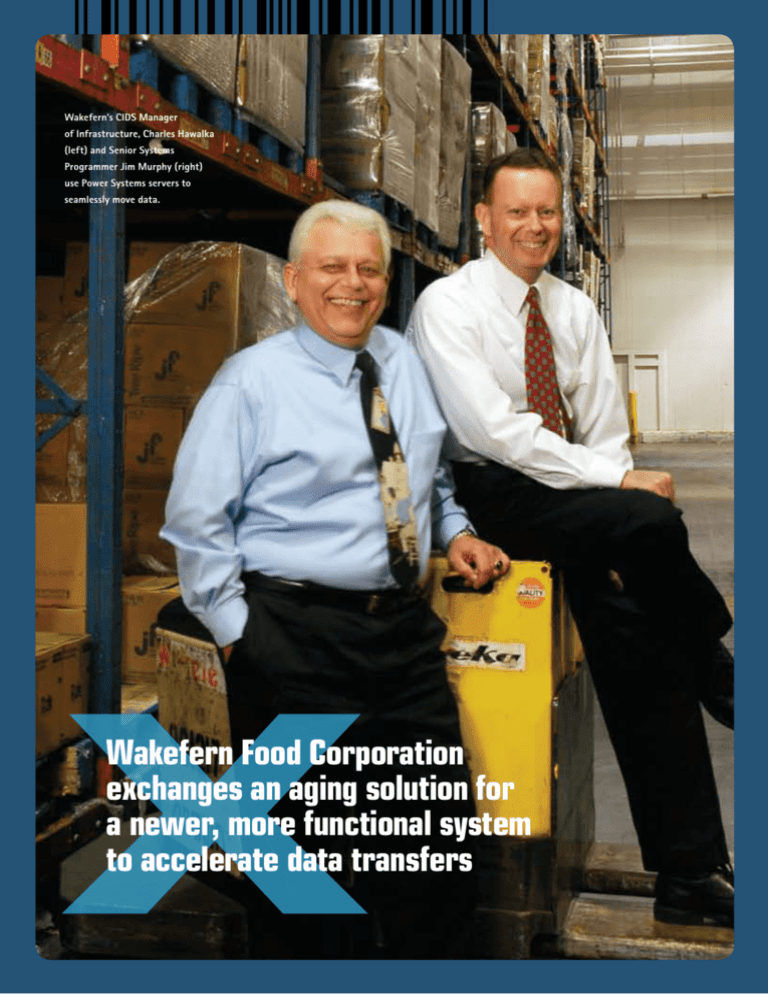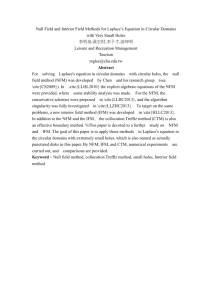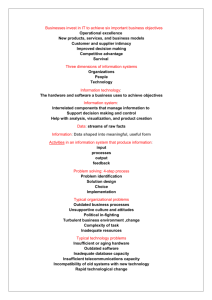Read their story here or in IBM's Systems
advertisement

Wakefern’s CIDS Manager of Infrastructure, Charles Hawalka (left) and Senior Systems Programmer Jim Murphy (right) use Power Systems servers to seamlessly move data. Wakefern Food Corporation exchanges an aging solution for a newer, more functional system to accelerate data transfers IBM Systems M A G A Z I N E IBM Systems E change x Rite M A G A Z I N E IBM Systems IBM Systems IBM Systems M A G A Z I N E M A G A Z I N E M A G A Z I N E by Jim Utsler photograhy by michael crouser I n today’s fast-paced world of backand-forth data communications, older technologies aren’t enough to help companies operate as efficiently as their executives would like. Prior to deploying TPS/NetWork File Manager (NFM) from TPS Systems, Wakefern Food Corporation used System Network Architecture (SNA) and NetView* Distribution Manager (N V DM) on an I BM System z9* Enter pr ise Class (System z9 EC) server for much of its datacommunications requirements. These requirements included data transfers with the IBM System p* servers in the data center, as well as the System p servers and IBM 4690 point-of-sale OS located at each s tor e. T h i s SN A / N V DM d at a-t r a n sfe r method was no longer viable, especially as the company continued to grow. Data transfers from its member stores sometimes took hours to finalize. To address these and other issues, Wakefern searched for a faster, more fully functioning, open standards-based solution to take the place of the company’s SNA/NetView datatransfer method. The solution ended up being TPS IP-based NFM. Thanks to this change in solutions, hour-long transfers now take 10 minutes from start to finish, with guaranteed deliveries. A Big Footprint Wakefern is a retailer-owned cooperative that began 60 years ago when eight independent grocers joined forces for greater buying power. That cooperative has grown to include 45 members who together own more than 200 ShopRite stores in New Jersey, New York, F E B R U A R Y/ M A R C H 2 0 0 9 i b m s y s t e m s m a g.c o m/a i x 11 Posted with permission from IBM Systems Magazine, Power Systems — AIX edition. Connecticut, Pennsylvania and Delaware. A second retail banner, PriceRite, was established in 1985 as a wholly owned subsidiary of Wakefern and today includes 36 stores located in Rhode Island, Massachusetts, New York, Connecticut and Pennsylvania. Wakefern supports retailers with product procurement, warehousing and transportation services. Because of this arrangement, Wakefern’s members and their wholesale customers can buy in volume at lower prices. According to Charles Hawalka, manager of infrastructure with Wakefern’s Computer Information Ser vices Division (CISD), “This arrangement allows us to pass those savings on to consumers, making us a market leader in our trading area.” Headquartered in Keasbey, N.J., Wakefern operates more than 2.5 million square-feet of warehouse space and has one of the largest transportation fleets on the East Coast. Its 400 tractors and 2,000 trailers traveled more than 35 million miles in 2007. Wakefern manages all of the IT systems at the ShopRite and PriceRite stores, including each store’s IBM System p 520s and IBM 4690s, as well as its own back-office System p 520 servers and the System z9 EC. As one might expect, there’s much back and forth between these systems— as well as those of Wakefern’s business partners—to support the cooperative. “We r un between 1,000 to 1,500 f iletransfer processes a day,” says Jim Murphy, senior systems programmer with Wakefern’s CISD. These include pricing information, order files and pharmacy information. Additionally, Wakefern conducts complete, daily backups of each ser ver at each store. A ll together, “close to 50 gigabytes of data a day” are backed up, Murphy remarks. This surely isn’t a trifling number, and is one that demands much bandwidth and a speedy form of data transport. SNA and NetView, as Hawalka points out, simply “weren’t up to that task. It used to take hours just to pull the stores’ terminal log files from the 4690s. We needed an IP solution that would allow us to replace SNA and NVDM. We needed an IP solution to move forward.” Automatic Conversions With these concerns in mind, Wakefern began examining alternatives to its SNA/NetView mode of communications. Between 2001 and 2003, the company evaluated many replacement solutions, discussed the situation with several vendors and tested some of the products. Most of them, however, “didn’t have the functionality we needed,” Hawalka recalls. Except, that is, for TPS’s NFM. Once Wakefern selected TPS, the company began converting data feeds from NVDM to NFM in March 2003 and completed them within six months without having to change any of the data-processing programming on the mainframe, its many System p servers, 12 F E B R U A R Y/ M A R C H 2 0 0 9 i b m s y s t e m s m a g.c o m/a i x its Windows* OS-based boxes and the 4690 platform. “NFM automatically converts the data to an ASCII or EBCDIC format,” Murphy says. A n ot h e r k e y c om p on e n t t o t h e s ol u t i on w a s i t s similarity to NVDM. Both NFM and NVDM use comparable terminology, which made it easier for Wakefern to transition to the new product. As Hawalka explains, “TPS did a good job designing NFM to replace NVDM. And at the same time, UP CLOSE CUSTOMER: Wakefern Food Corporation HEADQUARTERS: Keasbey, N.J. BUSINESS: Supplier, warehouser and transporter for retail-based cooperative HARDWARE: Hundreds of IBM System p 520s and older AIX OS-based servers, as well as an IBM System z9 Enterprise Class SOFTWARE: The IBM 4690 point-of-sale OS and TPS/ NetWork File Manager from TPS Systems CHALLENGE: Improving data exchanges between itself, its retail partners and its vendors SOLUTION: Replacing the increasingly outmoded SNA and NetView Distribution Manager and dial-up connections with the IP-based TPS/NetWork File Manager The NFM framework actually resides on the UNIX server, but we can view the file transfers, maintain NFM configuration information and manage file-transfer schedules using Internet Explorer.” —Jim Murphy, Senior Systems Programmer, Wakefern CISD they enhanced it, giving it more functionality than NVDM.” One such additional function was the capabilit y for the company to use data-encryption products when it uses NFM’s FTP to exchange files with business partners. Additionally, NFM compresses data between socket lines, which has significantly reduced the amount of traffic on the Wakefern network. This means all of the back-and-forth data transfers are much quicker than before. Murphy notes one example of this, saying, “With our old network and NDM, it might take a half an hour to pull a five or six megabyte terminal log file from a store’s 4690. With NFM, it takes seconds.” Because of these streamlined and faster data transfers, the company no longer has to move data during business hours. Now, it can do the processing and back-end integration at night. When people come to work in the morning, all of the information they need is immediately available. Notably, if some required data-transfer function wasn’t already built into the TPS NFM, TPS would add it to enhance the capabilities of the solution and make it easier for Wakefern to meet all of its data-communications goals. For example, TPS added Job Entry System (JES) Services to the Wakefern’s NFM deployment so the company could direct its mainframe reporting to a file-imaging solution. “In t he past, we had been using batch F T P to move mainframe reporting output to a centralized server for storing the data and allowing it to be browser viewable, but it was a very cumbersome process,” Murphy notes. “So TPS added an interface to retrieve reports right out of the JES queue on a scheduled basis and send it to that server so it can be easily viewed by end users.” Wakefern is now using TPS NFM—which supports many servers and clients, including the System p and System z* platforms, Linux* and Windows—to move all of its data, both with its retail members, its business partners and internally, between systems. This solution provides a centralized transfer solution integrated with all of the hardware and software platforms deployed at Wakefern. Additionally, NFM has a graphical interface that allows the company’s operations staff to monitor and control all of its file-transfer requirements in real time, ensuring guaranteed delivery. As Murphy explains, “The NFM framework actually resides on the UNIX* ser ver, but we can view the file transfers, maintain NFM configuration information and manage filetransfer schedules using Internet Explorer.” The operations staff now knows what was delivered and what wasn’t. If something wasn’t delivered, they can easily recognize that, make the necessary adjustments and resubmit the job. A Controlled Implementation As with all IT undertakings, projects never seem to end. Wakefern began the NFM data-transfer rollout with some 400 systems and is now up to 780. And as Murphy points out, “We’re still growing it.” This step-at-a-time approach has been deliberate; both Hawalka and Murphy know a controlled implementation is often better than a big-bang deployment. Any minor hiccups the company might’ve had during the implementation were easily rectified with no loss in productivity. Because the company has much experience with the product, it can easily bring other companies, stores and business partners into this new data-transfer fold. That approach has paid off. According to Hawalka, the TPS solution had an “ROI of approximately two years.” p Jim Utsler, I BM Systems Magazine senior writer, has been covering technology for more than a decade. Jim can be reached at jutsler@ msptechmedia.com. F E B R U A R Y/ M A R C H 2 0 0 9 i b m s y s t e m s m a g.c o m/a i x 13




